THE ADVANCED ISSUES IN ACCOUNTING
VerifiedAdded on 2022/07/28
|10
|2961
|17
AI Summary
Contribute Materials
Your contribution can guide someone’s learning journey. Share your
documents today.
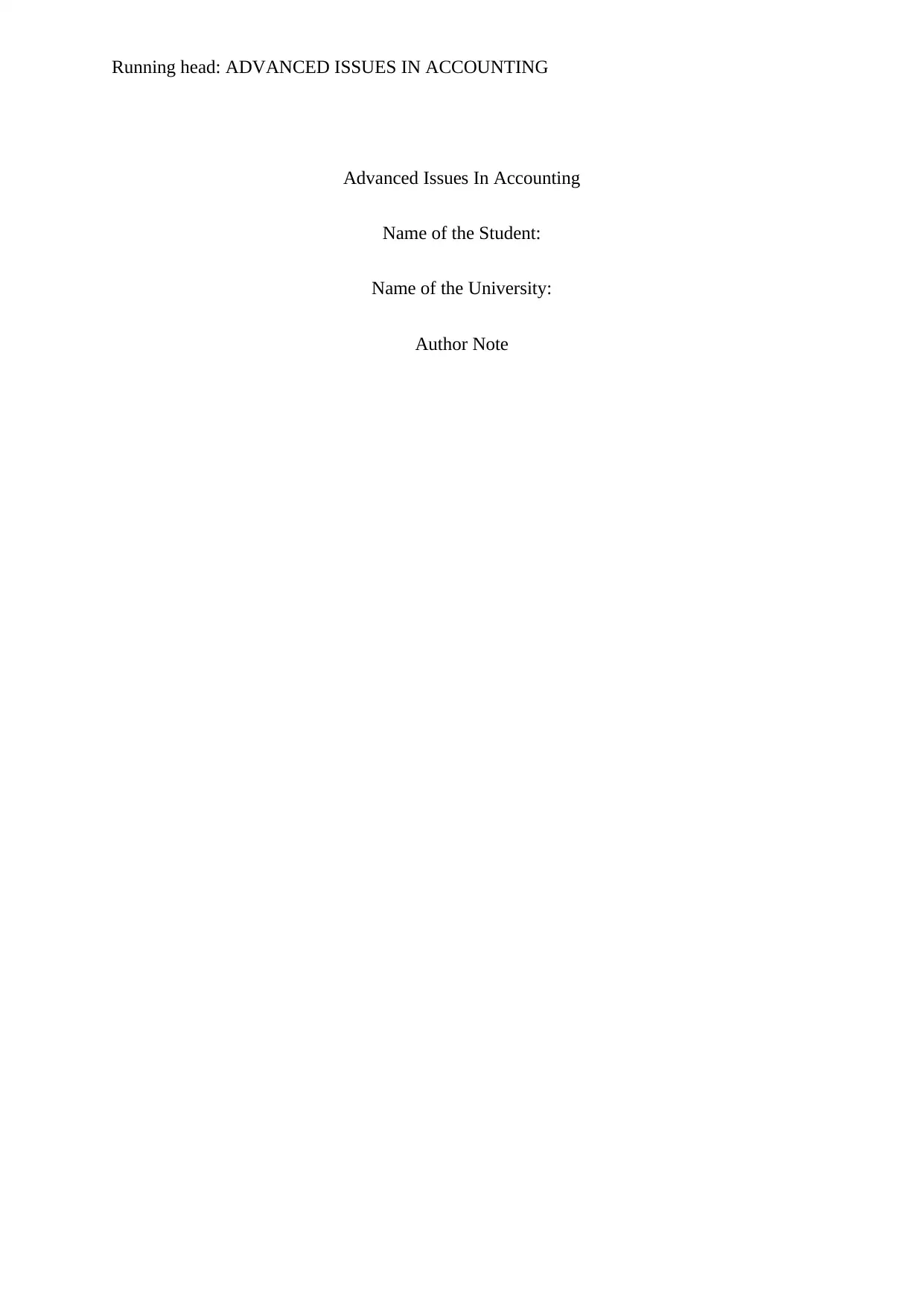
Running head: ADVANCED ISSUES IN ACCOUNTING
Advanced Issues In Accounting
Name of the Student:
Name of the University:
Author Note
Advanced Issues In Accounting
Name of the Student:
Name of the University:
Author Note
Secure Best Marks with AI Grader
Need help grading? Try our AI Grader for instant feedback on your assignments.
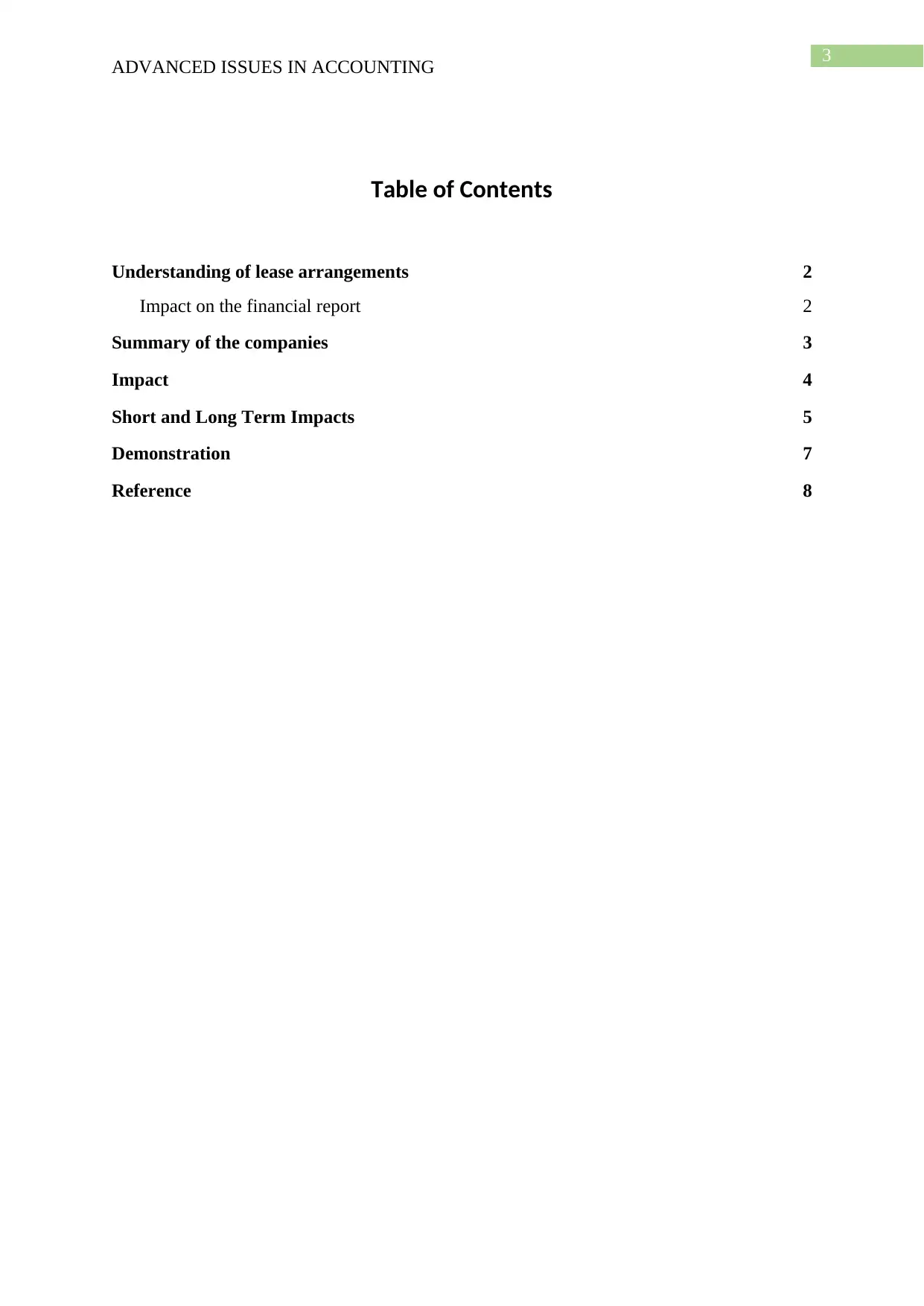
3
ADVANCED ISSUES IN ACCOUNTING
Table of Contents
Understanding of lease arrangements 2
Impact on the financial report 2
Summary of the companies 3
Impact 4
Short and Long Term Impacts 5
Demonstration 7
Reference 8
ADVANCED ISSUES IN ACCOUNTING
Table of Contents
Understanding of lease arrangements 2
Impact on the financial report 2
Summary of the companies 3
Impact 4
Short and Long Term Impacts 5
Demonstration 7
Reference 8
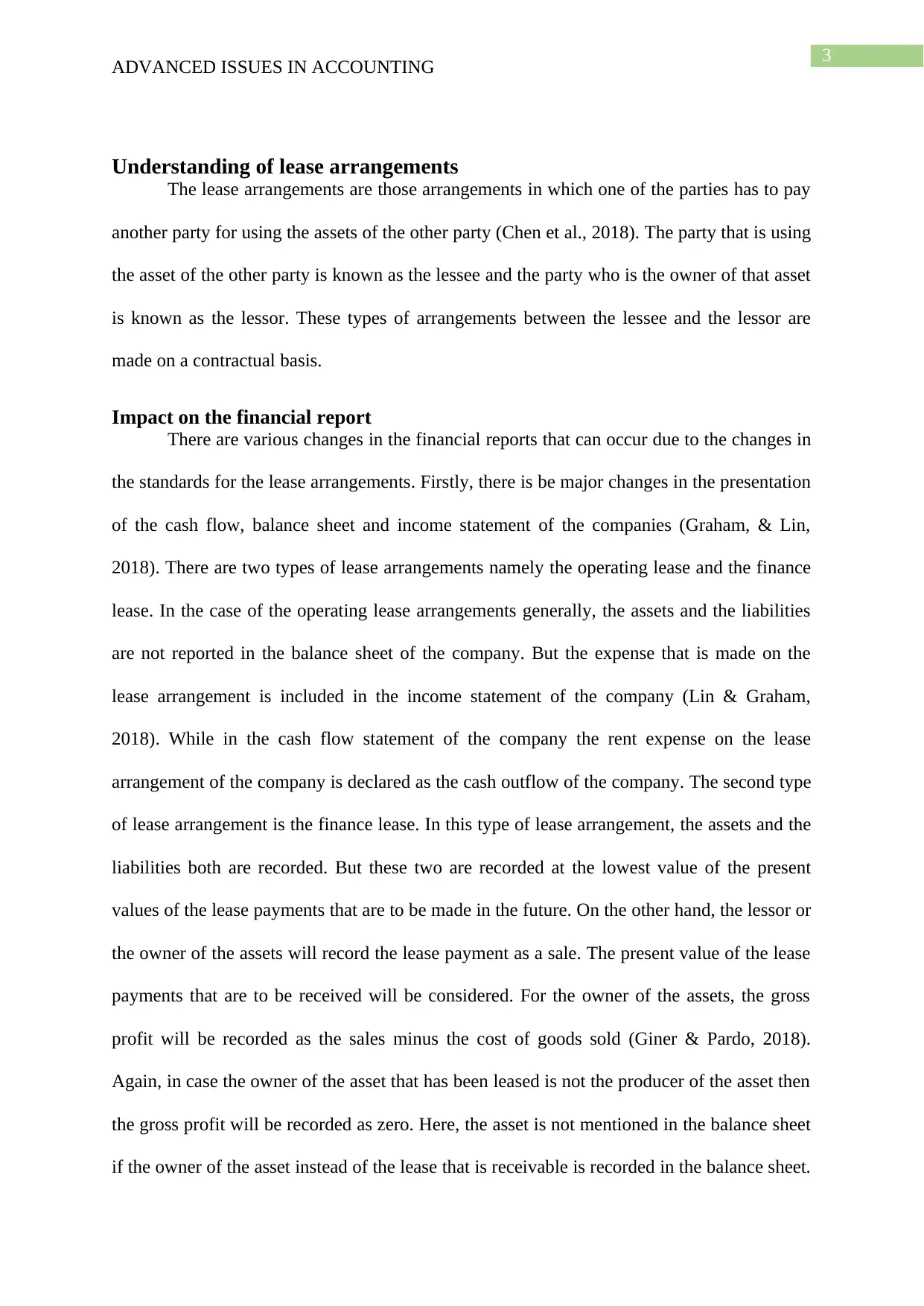
3
ADVANCED ISSUES IN ACCOUNTING
Understanding of lease arrangements
The lease arrangements are those arrangements in which one of the parties has to pay
another party for using the assets of the other party (Chen et al., 2018). The party that is using
the asset of the other party is known as the lessee and the party who is the owner of that asset
is known as the lessor. These types of arrangements between the lessee and the lessor are
made on a contractual basis.
Impact on the financial report
There are various changes in the financial reports that can occur due to the changes in
the standards for the lease arrangements. Firstly, there is be major changes in the presentation
of the cash flow, balance sheet and income statement of the companies (Graham, & Lin,
2018). There are two types of lease arrangements namely the operating lease and the finance
lease. In the case of the operating lease arrangements generally, the assets and the liabilities
are not reported in the balance sheet of the company. But the expense that is made on the
lease arrangement is included in the income statement of the company (Lin & Graham,
2018). While in the cash flow statement of the company the rent expense on the lease
arrangement of the company is declared as the cash outflow of the company. The second type
of lease arrangement is the finance lease. In this type of lease arrangement, the assets and the
liabilities both are recorded. But these two are recorded at the lowest value of the present
values of the lease payments that are to be made in the future. On the other hand, the lessor or
the owner of the assets will record the lease payment as a sale. The present value of the lease
payments that are to be received will be considered. For the owner of the assets, the gross
profit will be recorded as the sales minus the cost of goods sold (Giner & Pardo, 2018).
Again, in case the owner of the asset that has been leased is not the producer of the asset then
the gross profit will be recorded as zero. Here, the asset is not mentioned in the balance sheet
if the owner of the asset instead of the lease that is receivable is recorded in the balance sheet.
ADVANCED ISSUES IN ACCOUNTING
Understanding of lease arrangements
The lease arrangements are those arrangements in which one of the parties has to pay
another party for using the assets of the other party (Chen et al., 2018). The party that is using
the asset of the other party is known as the lessee and the party who is the owner of that asset
is known as the lessor. These types of arrangements between the lessee and the lessor are
made on a contractual basis.
Impact on the financial report
There are various changes in the financial reports that can occur due to the changes in
the standards for the lease arrangements. Firstly, there is be major changes in the presentation
of the cash flow, balance sheet and income statement of the companies (Graham, & Lin,
2018). There are two types of lease arrangements namely the operating lease and the finance
lease. In the case of the operating lease arrangements generally, the assets and the liabilities
are not reported in the balance sheet of the company. But the expense that is made on the
lease arrangement is included in the income statement of the company (Lin & Graham,
2018). While in the cash flow statement of the company the rent expense on the lease
arrangement of the company is declared as the cash outflow of the company. The second type
of lease arrangement is the finance lease. In this type of lease arrangement, the assets and the
liabilities both are recorded. But these two are recorded at the lowest value of the present
values of the lease payments that are to be made in the future. On the other hand, the lessor or
the owner of the assets will record the lease payment as a sale. The present value of the lease
payments that are to be received will be considered. For the owner of the assets, the gross
profit will be recorded as the sales minus the cost of goods sold (Giner & Pardo, 2018).
Again, in case the owner of the asset that has been leased is not the producer of the asset then
the gross profit will be recorded as zero. Here, the asset is not mentioned in the balance sheet
if the owner of the asset instead of the lease that is receivable is recorded in the balance sheet.
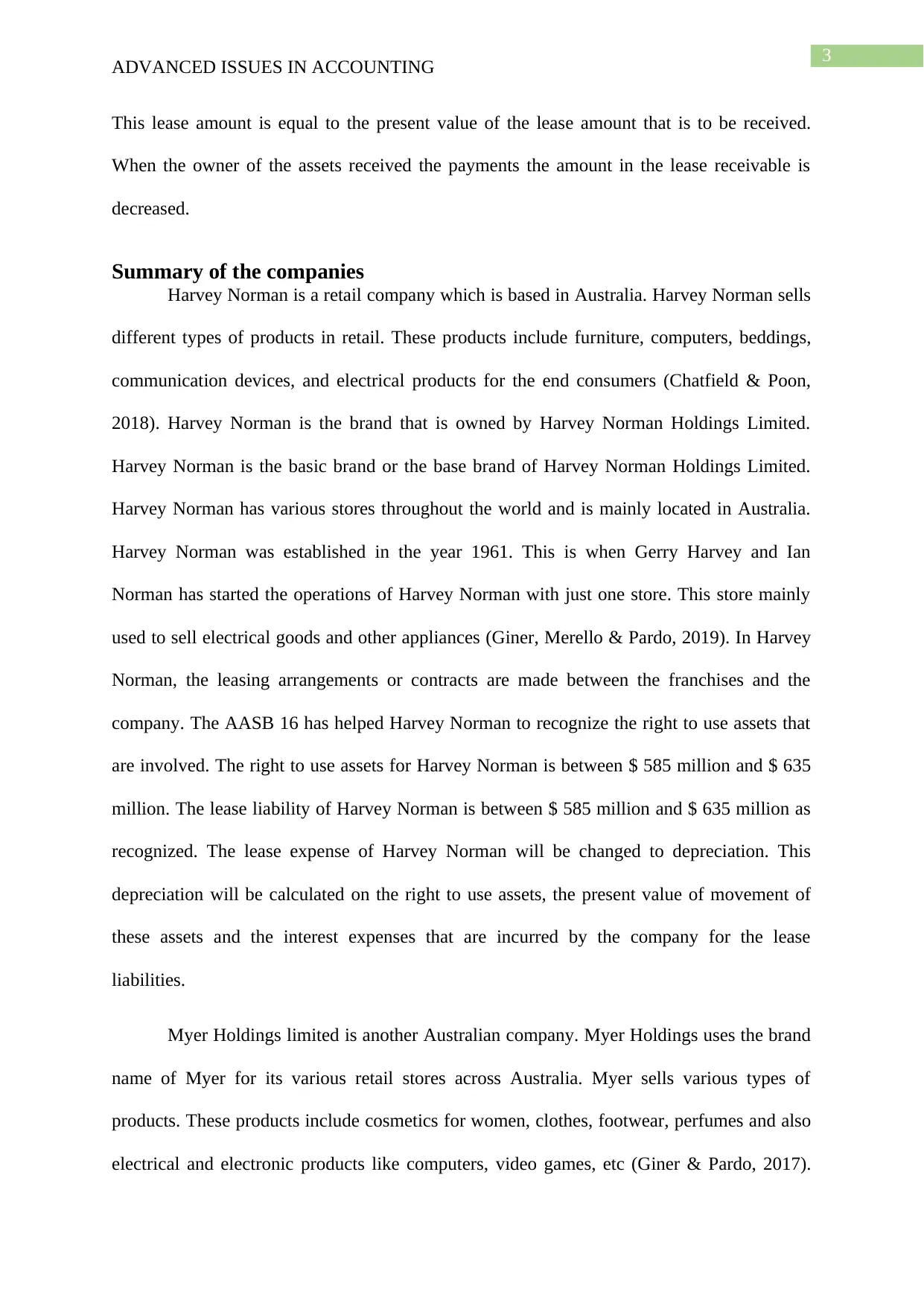
3
ADVANCED ISSUES IN ACCOUNTING
This lease amount is equal to the present value of the lease amount that is to be received.
When the owner of the assets received the payments the amount in the lease receivable is
decreased.
Summary of the companies
Harvey Norman is a retail company which is based in Australia. Harvey Norman sells
different types of products in retail. These products include furniture, computers, beddings,
communication devices, and electrical products for the end consumers (Chatfield & Poon,
2018). Harvey Norman is the brand that is owned by Harvey Norman Holdings Limited.
Harvey Norman is the basic brand or the base brand of Harvey Norman Holdings Limited.
Harvey Norman has various stores throughout the world and is mainly located in Australia.
Harvey Norman was established in the year 1961. This is when Gerry Harvey and Ian
Norman has started the operations of Harvey Norman with just one store. This store mainly
used to sell electrical goods and other appliances (Giner, Merello & Pardo, 2019). In Harvey
Norman, the leasing arrangements or contracts are made between the franchises and the
company. The AASB 16 has helped Harvey Norman to recognize the right to use assets that
are involved. The right to use assets for Harvey Norman is between $ 585 million and $ 635
million. The lease liability of Harvey Norman is between $ 585 million and $ 635 million as
recognized. The lease expense of Harvey Norman will be changed to depreciation. This
depreciation will be calculated on the right to use assets, the present value of movement of
these assets and the interest expenses that are incurred by the company for the lease
liabilities.
Myer Holdings limited is another Australian company. Myer Holdings uses the brand
name of Myer for its various retail stores across Australia. Myer sells various types of
products. These products include cosmetics for women, clothes, footwear, perfumes and also
electrical and electronic products like computers, video games, etc (Giner & Pardo, 2017).
ADVANCED ISSUES IN ACCOUNTING
This lease amount is equal to the present value of the lease amount that is to be received.
When the owner of the assets received the payments the amount in the lease receivable is
decreased.
Summary of the companies
Harvey Norman is a retail company which is based in Australia. Harvey Norman sells
different types of products in retail. These products include furniture, computers, beddings,
communication devices, and electrical products for the end consumers (Chatfield & Poon,
2018). Harvey Norman is the brand that is owned by Harvey Norman Holdings Limited.
Harvey Norman is the basic brand or the base brand of Harvey Norman Holdings Limited.
Harvey Norman has various stores throughout the world and is mainly located in Australia.
Harvey Norman was established in the year 1961. This is when Gerry Harvey and Ian
Norman has started the operations of Harvey Norman with just one store. This store mainly
used to sell electrical goods and other appliances (Giner, Merello & Pardo, 2019). In Harvey
Norman, the leasing arrangements or contracts are made between the franchises and the
company. The AASB 16 has helped Harvey Norman to recognize the right to use assets that
are involved. The right to use assets for Harvey Norman is between $ 585 million and $ 635
million. The lease liability of Harvey Norman is between $ 585 million and $ 635 million as
recognized. The lease expense of Harvey Norman will be changed to depreciation. This
depreciation will be calculated on the right to use assets, the present value of movement of
these assets and the interest expenses that are incurred by the company for the lease
liabilities.
Myer Holdings limited is another Australian company. Myer Holdings uses the brand
name of Myer for its various retail stores across Australia. Myer sells various types of
products. These products include cosmetics for women, clothes, footwear, perfumes and also
electrical and electronic products like computers, video games, etc (Giner & Pardo, 2017).
Secure Best Marks with AI Grader
Need help grading? Try our AI Grader for instant feedback on your assignments.
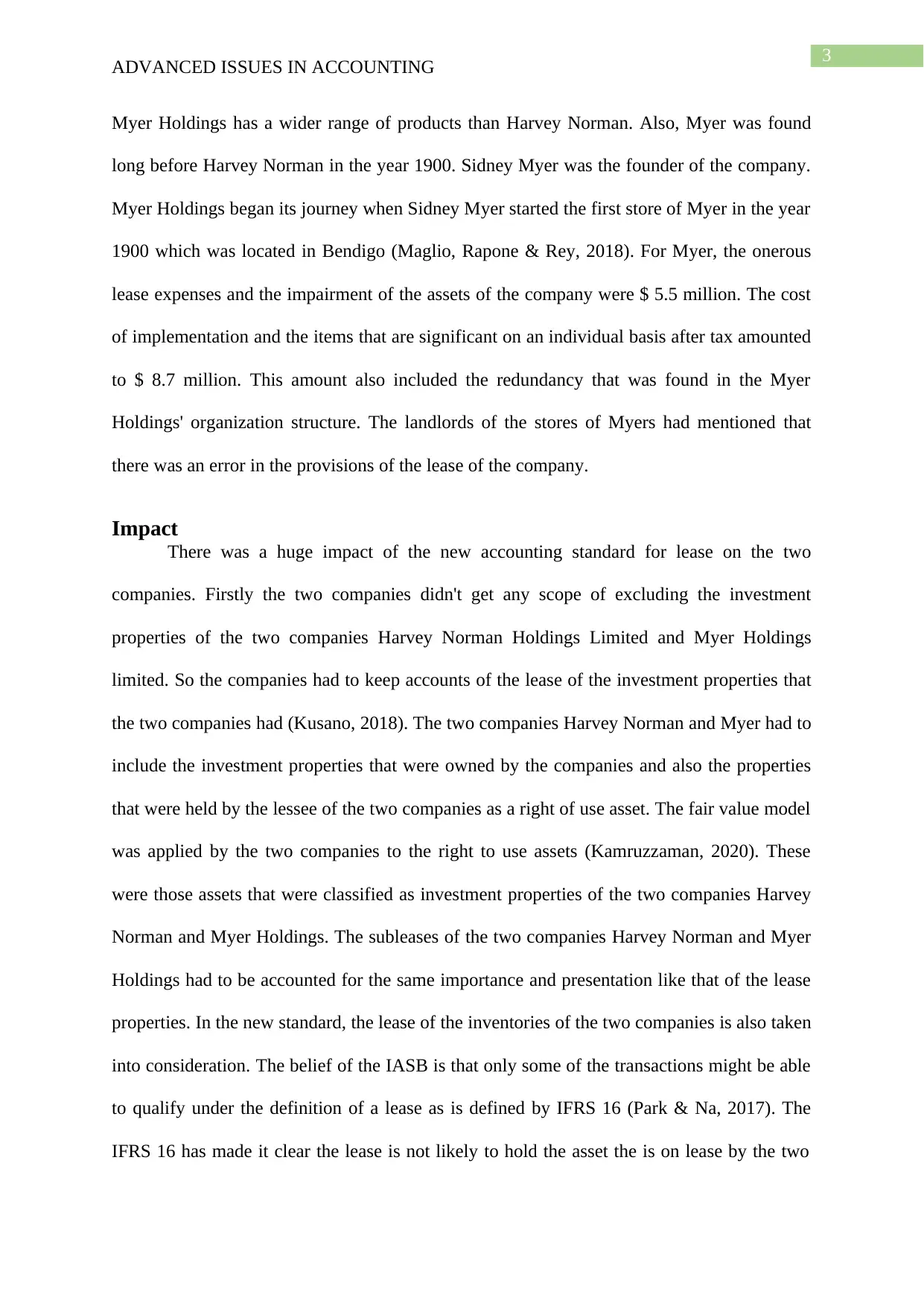
3
ADVANCED ISSUES IN ACCOUNTING
Myer Holdings has a wider range of products than Harvey Norman. Also, Myer was found
long before Harvey Norman in the year 1900. Sidney Myer was the founder of the company.
Myer Holdings began its journey when Sidney Myer started the first store of Myer in the year
1900 which was located in Bendigo (Maglio, Rapone & Rey, 2018). For Myer, the onerous
lease expenses and the impairment of the assets of the company were $ 5.5 million. The cost
of implementation and the items that are significant on an individual basis after tax amounted
to $ 8.7 million. This amount also included the redundancy that was found in the Myer
Holdings' organization structure. The landlords of the stores of Myers had mentioned that
there was an error in the provisions of the lease of the company.
Impact
There was a huge impact of the new accounting standard for lease on the two
companies. Firstly the two companies didn't get any scope of excluding the investment
properties of the two companies Harvey Norman Holdings Limited and Myer Holdings
limited. So the companies had to keep accounts of the lease of the investment properties that
the two companies had (Kusano, 2018). The two companies Harvey Norman and Myer had to
include the investment properties that were owned by the companies and also the properties
that were held by the lessee of the two companies as a right of use asset. The fair value model
was applied by the two companies to the right to use assets (Kamruzzaman, 2020). These
were those assets that were classified as investment properties of the two companies Harvey
Norman and Myer Holdings. The subleases of the two companies Harvey Norman and Myer
Holdings had to be accounted for the same importance and presentation like that of the lease
properties. In the new standard, the lease of the inventories of the two companies is also taken
into consideration. The belief of the IASB is that only some of the transactions might be able
to qualify under the definition of a lease as is defined by IFRS 16 (Park & Na, 2017). The
IFRS 16 has made it clear the lease is not likely to hold the asset the is on lease by the two
ADVANCED ISSUES IN ACCOUNTING
Myer Holdings has a wider range of products than Harvey Norman. Also, Myer was found
long before Harvey Norman in the year 1900. Sidney Myer was the founder of the company.
Myer Holdings began its journey when Sidney Myer started the first store of Myer in the year
1900 which was located in Bendigo (Maglio, Rapone & Rey, 2018). For Myer, the onerous
lease expenses and the impairment of the assets of the company were $ 5.5 million. The cost
of implementation and the items that are significant on an individual basis after tax amounted
to $ 8.7 million. This amount also included the redundancy that was found in the Myer
Holdings' organization structure. The landlords of the stores of Myers had mentioned that
there was an error in the provisions of the lease of the company.
Impact
There was a huge impact of the new accounting standard for lease on the two
companies. Firstly the two companies didn't get any scope of excluding the investment
properties of the two companies Harvey Norman Holdings Limited and Myer Holdings
limited. So the companies had to keep accounts of the lease of the investment properties that
the two companies had (Kusano, 2018). The two companies Harvey Norman and Myer had to
include the investment properties that were owned by the companies and also the properties
that were held by the lessee of the two companies as a right of use asset. The fair value model
was applied by the two companies to the right to use assets (Kamruzzaman, 2020). These
were those assets that were classified as investment properties of the two companies Harvey
Norman and Myer Holdings. The subleases of the two companies Harvey Norman and Myer
Holdings had to be accounted for the same importance and presentation like that of the lease
properties. In the new standard, the lease of the inventories of the two companies is also taken
into consideration. The belief of the IASB is that only some of the transactions might be able
to qualify under the definition of a lease as is defined by IFRS 16 (Park & Na, 2017). The
IFRS 16 has made it clear the lease is not likely to hold the asset the is on lease by the two
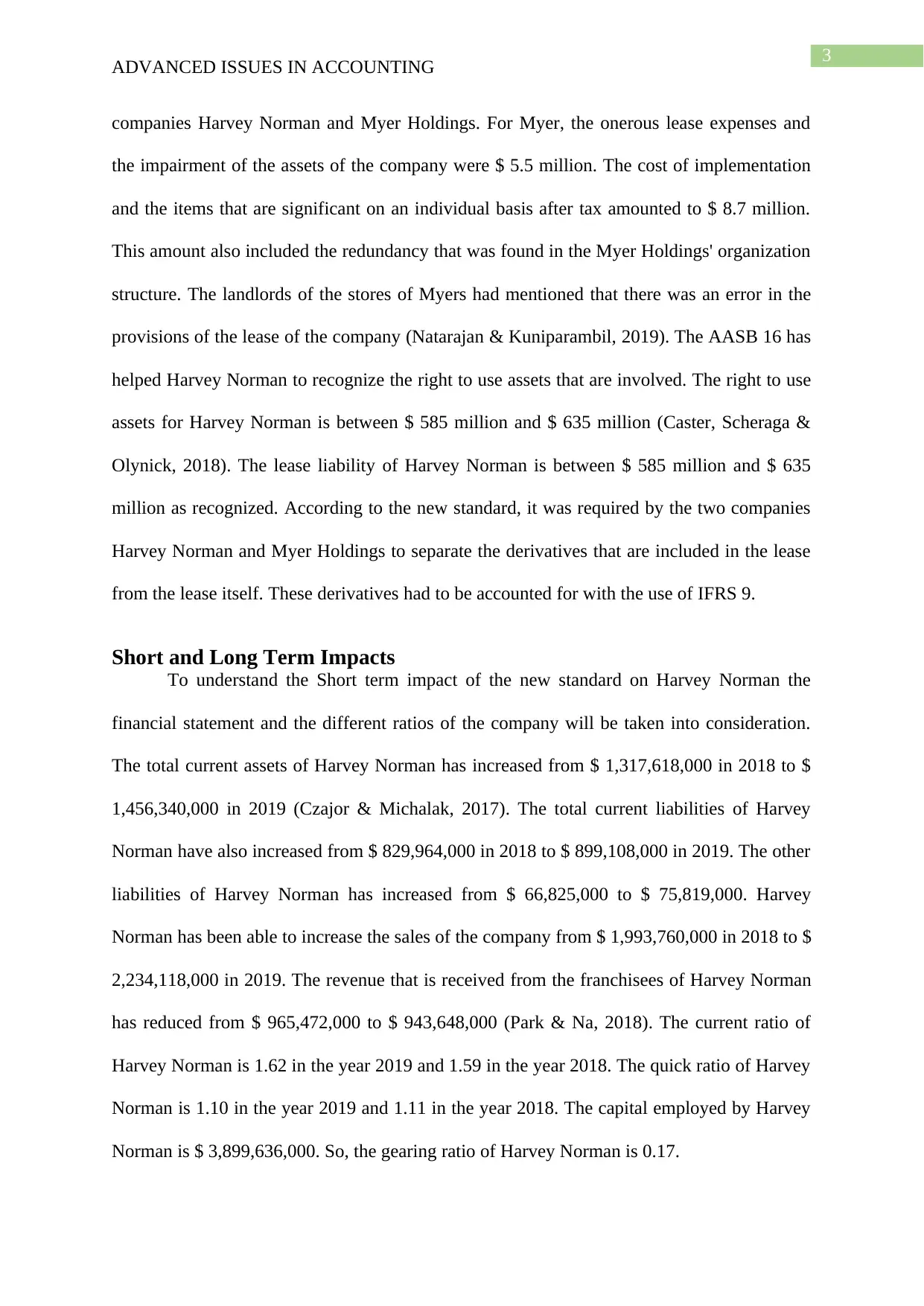
3
ADVANCED ISSUES IN ACCOUNTING
companies Harvey Norman and Myer Holdings. For Myer, the onerous lease expenses and
the impairment of the assets of the company were $ 5.5 million. The cost of implementation
and the items that are significant on an individual basis after tax amounted to $ 8.7 million.
This amount also included the redundancy that was found in the Myer Holdings' organization
structure. The landlords of the stores of Myers had mentioned that there was an error in the
provisions of the lease of the company (Natarajan & Kuniparambil, 2019). The AASB 16 has
helped Harvey Norman to recognize the right to use assets that are involved. The right to use
assets for Harvey Norman is between $ 585 million and $ 635 million (Caster, Scheraga &
Olynick, 2018). The lease liability of Harvey Norman is between $ 585 million and $ 635
million as recognized. According to the new standard, it was required by the two companies
Harvey Norman and Myer Holdings to separate the derivatives that are included in the lease
from the lease itself. These derivatives had to be accounted for with the use of IFRS 9.
Short and Long Term Impacts
To understand the Short term impact of the new standard on Harvey Norman the
financial statement and the different ratios of the company will be taken into consideration.
The total current assets of Harvey Norman has increased from $ 1,317,618,000 in 2018 to $
1,456,340,000 in 2019 (Czajor & Michalak, 2017). The total current liabilities of Harvey
Norman have also increased from $ 829,964,000 in 2018 to $ 899,108,000 in 2019. The other
liabilities of Harvey Norman has increased from $ 66,825,000 to $ 75,819,000. Harvey
Norman has been able to increase the sales of the company from $ 1,993,760,000 in 2018 to $
2,234,118,000 in 2019. The revenue that is received from the franchisees of Harvey Norman
has reduced from $ 965,472,000 to $ 943,648,000 (Park & Na, 2018). The current ratio of
Harvey Norman is 1.62 in the year 2019 and 1.59 in the year 2018. The quick ratio of Harvey
Norman is 1.10 in the year 2019 and 1.11 in the year 2018. The capital employed by Harvey
Norman is $ 3,899,636,000. So, the gearing ratio of Harvey Norman is 0.17.
ADVANCED ISSUES IN ACCOUNTING
companies Harvey Norman and Myer Holdings. For Myer, the onerous lease expenses and
the impairment of the assets of the company were $ 5.5 million. The cost of implementation
and the items that are significant on an individual basis after tax amounted to $ 8.7 million.
This amount also included the redundancy that was found in the Myer Holdings' organization
structure. The landlords of the stores of Myers had mentioned that there was an error in the
provisions of the lease of the company (Natarajan & Kuniparambil, 2019). The AASB 16 has
helped Harvey Norman to recognize the right to use assets that are involved. The right to use
assets for Harvey Norman is between $ 585 million and $ 635 million (Caster, Scheraga &
Olynick, 2018). The lease liability of Harvey Norman is between $ 585 million and $ 635
million as recognized. According to the new standard, it was required by the two companies
Harvey Norman and Myer Holdings to separate the derivatives that are included in the lease
from the lease itself. These derivatives had to be accounted for with the use of IFRS 9.
Short and Long Term Impacts
To understand the Short term impact of the new standard on Harvey Norman the
financial statement and the different ratios of the company will be taken into consideration.
The total current assets of Harvey Norman has increased from $ 1,317,618,000 in 2018 to $
1,456,340,000 in 2019 (Czajor & Michalak, 2017). The total current liabilities of Harvey
Norman have also increased from $ 829,964,000 in 2018 to $ 899,108,000 in 2019. The other
liabilities of Harvey Norman has increased from $ 66,825,000 to $ 75,819,000. Harvey
Norman has been able to increase the sales of the company from $ 1,993,760,000 in 2018 to $
2,234,118,000 in 2019. The revenue that is received from the franchisees of Harvey Norman
has reduced from $ 965,472,000 to $ 943,648,000 (Park & Na, 2018). The current ratio of
Harvey Norman is 1.62 in the year 2019 and 1.59 in the year 2018. The quick ratio of Harvey
Norman is 1.10 in the year 2019 and 1.11 in the year 2018. The capital employed by Harvey
Norman is $ 3,899,636,000. So, the gearing ratio of Harvey Norman is 0.17.
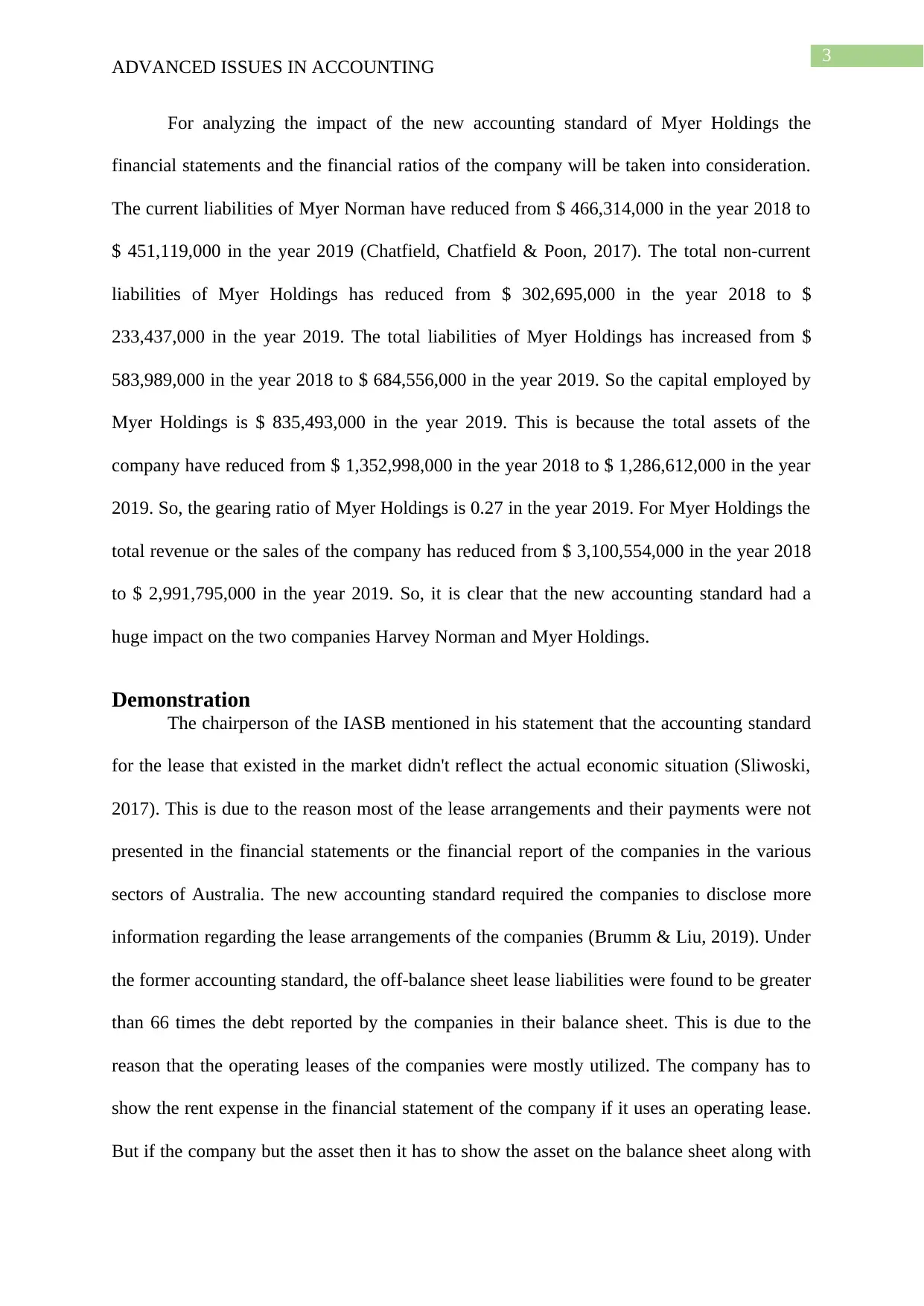
3
ADVANCED ISSUES IN ACCOUNTING
For analyzing the impact of the new accounting standard of Myer Holdings the
financial statements and the financial ratios of the company will be taken into consideration.
The current liabilities of Myer Norman have reduced from $ 466,314,000 in the year 2018 to
$ 451,119,000 in the year 2019 (Chatfield, Chatfield & Poon, 2017). The total non-current
liabilities of Myer Holdings has reduced from $ 302,695,000 in the year 2018 to $
233,437,000 in the year 2019. The total liabilities of Myer Holdings has increased from $
583,989,000 in the year 2018 to $ 684,556,000 in the year 2019. So the capital employed by
Myer Holdings is $ 835,493,000 in the year 2019. This is because the total assets of the
company have reduced from $ 1,352,998,000 in the year 2018 to $ 1,286,612,000 in the year
2019. So, the gearing ratio of Myer Holdings is 0.27 in the year 2019. For Myer Holdings the
total revenue or the sales of the company has reduced from $ 3,100,554,000 in the year 2018
to $ 2,991,795,000 in the year 2019. So, it is clear that the new accounting standard had a
huge impact on the two companies Harvey Norman and Myer Holdings.
Demonstration
The chairperson of the IASB mentioned in his statement that the accounting standard
for the lease that existed in the market didn't reflect the actual economic situation (Sliwoski,
2017). This is due to the reason most of the lease arrangements and their payments were not
presented in the financial statements or the financial report of the companies in the various
sectors of Australia. The new accounting standard required the companies to disclose more
information regarding the lease arrangements of the companies (Brumm & Liu, 2019). Under
the former accounting standard, the off-balance sheet lease liabilities were found to be greater
than 66 times the debt reported by the companies in their balance sheet. This is due to the
reason that the operating leases of the companies were mostly utilized. The company has to
show the rent expense in the financial statement of the company if it uses an operating lease.
But if the company but the asset then it has to show the asset on the balance sheet along with
ADVANCED ISSUES IN ACCOUNTING
For analyzing the impact of the new accounting standard of Myer Holdings the
financial statements and the financial ratios of the company will be taken into consideration.
The current liabilities of Myer Norman have reduced from $ 466,314,000 in the year 2018 to
$ 451,119,000 in the year 2019 (Chatfield, Chatfield & Poon, 2017). The total non-current
liabilities of Myer Holdings has reduced from $ 302,695,000 in the year 2018 to $
233,437,000 in the year 2019. The total liabilities of Myer Holdings has increased from $
583,989,000 in the year 2018 to $ 684,556,000 in the year 2019. So the capital employed by
Myer Holdings is $ 835,493,000 in the year 2019. This is because the total assets of the
company have reduced from $ 1,352,998,000 in the year 2018 to $ 1,286,612,000 in the year
2019. So, the gearing ratio of Myer Holdings is 0.27 in the year 2019. For Myer Holdings the
total revenue or the sales of the company has reduced from $ 3,100,554,000 in the year 2018
to $ 2,991,795,000 in the year 2019. So, it is clear that the new accounting standard had a
huge impact on the two companies Harvey Norman and Myer Holdings.
Demonstration
The chairperson of the IASB mentioned in his statement that the accounting standard
for the lease that existed in the market didn't reflect the actual economic situation (Sliwoski,
2017). This is due to the reason most of the lease arrangements and their payments were not
presented in the financial statements or the financial report of the companies in the various
sectors of Australia. The new accounting standard required the companies to disclose more
information regarding the lease arrangements of the companies (Brumm & Liu, 2019). Under
the former accounting standard, the off-balance sheet lease liabilities were found to be greater
than 66 times the debt reported by the companies in their balance sheet. This is due to the
reason that the operating leases of the companies were mostly utilized. The company has to
show the rent expense in the financial statement of the company if it uses an operating lease.
But if the company but the asset then it has to show the asset on the balance sheet along with
Paraphrase This Document
Need a fresh take? Get an instant paraphrase of this document with our AI Paraphraser
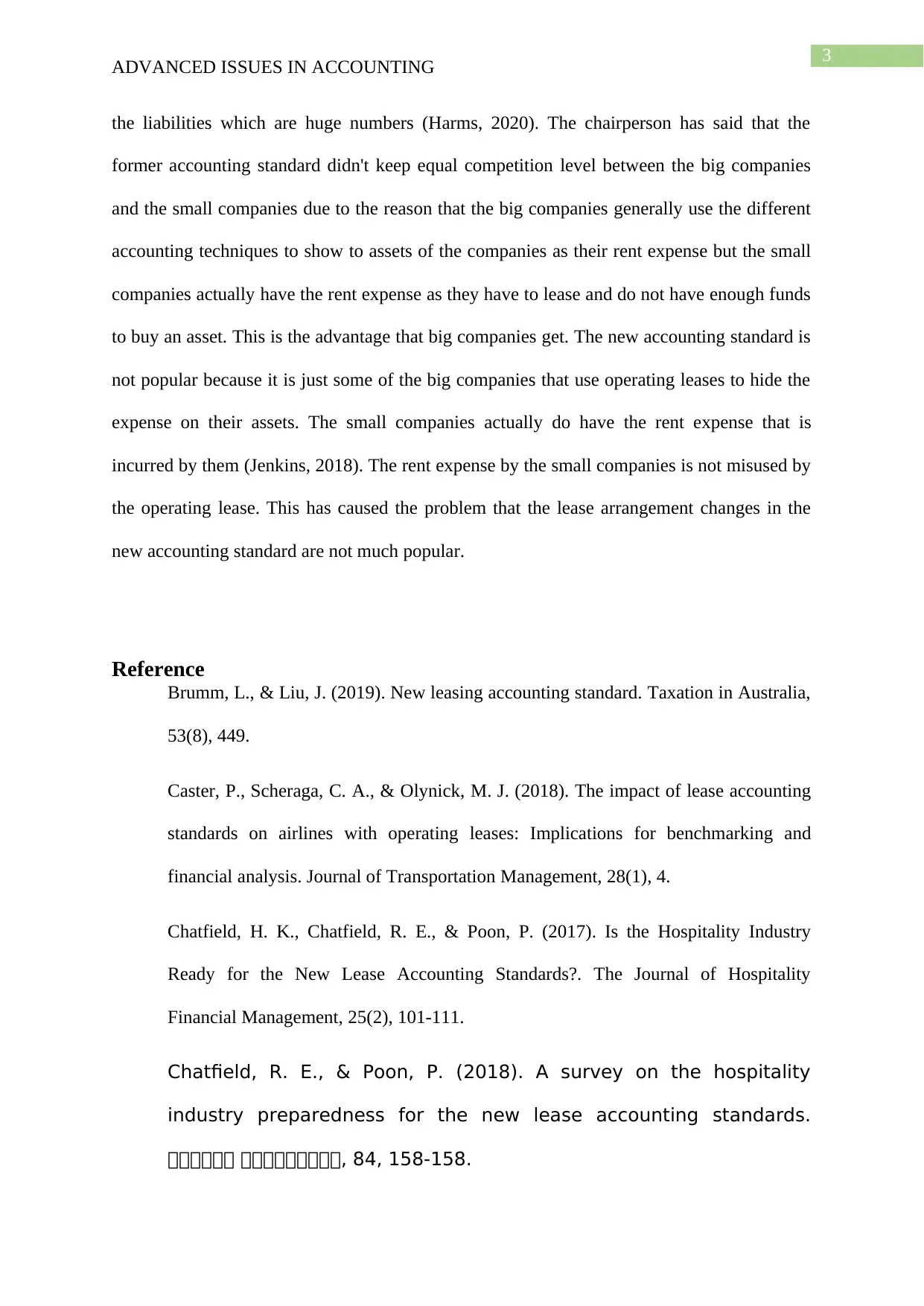
3
ADVANCED ISSUES IN ACCOUNTING
the liabilities which are huge numbers (Harms, 2020). The chairperson has said that the
former accounting standard didn't keep equal competition level between the big companies
and the small companies due to the reason that the big companies generally use the different
accounting techniques to show to assets of the companies as their rent expense but the small
companies actually have the rent expense as they have to lease and do not have enough funds
to buy an asset. This is the advantage that big companies get. The new accounting standard is
not popular because it is just some of the big companies that use operating leases to hide the
expense on their assets. The small companies actually do have the rent expense that is
incurred by them (Jenkins, 2018). The rent expense by the small companies is not misused by
the operating lease. This has caused the problem that the lease arrangement changes in the
new accounting standard are not much popular.
Reference
Brumm, L., & Liu, J. (2019). New leasing accounting standard. Taxation in Australia,
53(8), 449.
Caster, P., Scheraga, C. A., & Olynick, M. J. (2018). The impact of lease accounting
standards on airlines with operating leases: Implications for benchmarking and
financial analysis. Journal of Transportation Management, 28(1), 4.
Chatfield, H. K., Chatfield, R. E., & Poon, P. (2017). Is the Hospitality Industry
Ready for the New Lease Accounting Standards?. The Journal of Hospitality
Financial Management, 25(2), 101-111.
Chatfield, R. E., & Poon, P. (2018). A survey on the hospitality
industry preparedness for the new lease accounting standards.
한한한한한한 한한한한한한한한한, 84, 158-158.
ADVANCED ISSUES IN ACCOUNTING
the liabilities which are huge numbers (Harms, 2020). The chairperson has said that the
former accounting standard didn't keep equal competition level between the big companies
and the small companies due to the reason that the big companies generally use the different
accounting techniques to show to assets of the companies as their rent expense but the small
companies actually have the rent expense as they have to lease and do not have enough funds
to buy an asset. This is the advantage that big companies get. The new accounting standard is
not popular because it is just some of the big companies that use operating leases to hide the
expense on their assets. The small companies actually do have the rent expense that is
incurred by them (Jenkins, 2018). The rent expense by the small companies is not misused by
the operating lease. This has caused the problem that the lease arrangement changes in the
new accounting standard are not much popular.
Reference
Brumm, L., & Liu, J. (2019). New leasing accounting standard. Taxation in Australia,
53(8), 449.
Caster, P., Scheraga, C. A., & Olynick, M. J. (2018). The impact of lease accounting
standards on airlines with operating leases: Implications for benchmarking and
financial analysis. Journal of Transportation Management, 28(1), 4.
Chatfield, H. K., Chatfield, R. E., & Poon, P. (2017). Is the Hospitality Industry
Ready for the New Lease Accounting Standards?. The Journal of Hospitality
Financial Management, 25(2), 101-111.
Chatfield, R. E., & Poon, P. (2018). A survey on the hospitality
industry preparedness for the new lease accounting standards.
한한한한한한 한한한한한한한한한, 84, 158-158.
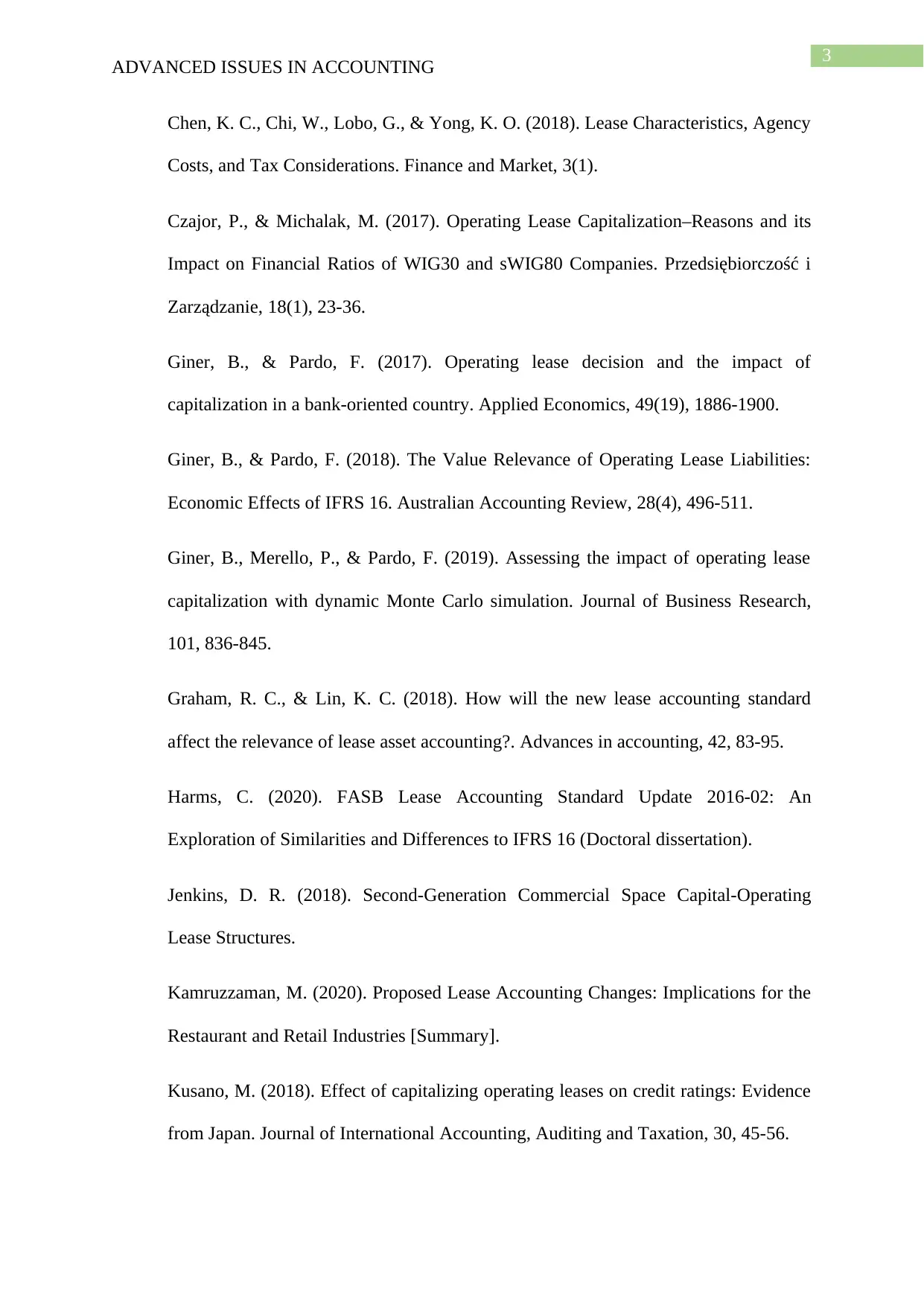
3
ADVANCED ISSUES IN ACCOUNTING
Chen, K. C., Chi, W., Lobo, G., & Yong, K. O. (2018). Lease Characteristics, Agency
Costs, and Tax Considerations. Finance and Market, 3(1).
Czajor, P., & Michalak, M. (2017). Operating Lease Capitalization–Reasons and its
Impact on Financial Ratios of WIG30 and sWIG80 Companies. Przedsiębiorczość i
Zarządzanie, 18(1), 23-36.
Giner, B., & Pardo, F. (2017). Operating lease decision and the impact of
capitalization in a bank-oriented country. Applied Economics, 49(19), 1886-1900.
Giner, B., & Pardo, F. (2018). The Value Relevance of Operating Lease Liabilities:
Economic Effects of IFRS 16. Australian Accounting Review, 28(4), 496-511.
Giner, B., Merello, P., & Pardo, F. (2019). Assessing the impact of operating lease
capitalization with dynamic Monte Carlo simulation. Journal of Business Research,
101, 836-845.
Graham, R. C., & Lin, K. C. (2018). How will the new lease accounting standard
affect the relevance of lease asset accounting?. Advances in accounting, 42, 83-95.
Harms, C. (2020). FASB Lease Accounting Standard Update 2016-02: An
Exploration of Similarities and Differences to IFRS 16 (Doctoral dissertation).
Jenkins, D. R. (2018). Second-Generation Commercial Space Capital-Operating
Lease Structures.
Kamruzzaman, M. (2020). Proposed Lease Accounting Changes: Implications for the
Restaurant and Retail Industries [Summary].
Kusano, M. (2018). Effect of capitalizing operating leases on credit ratings: Evidence
from Japan. Journal of International Accounting, Auditing and Taxation, 30, 45-56.
ADVANCED ISSUES IN ACCOUNTING
Chen, K. C., Chi, W., Lobo, G., & Yong, K. O. (2018). Lease Characteristics, Agency
Costs, and Tax Considerations. Finance and Market, 3(1).
Czajor, P., & Michalak, M. (2017). Operating Lease Capitalization–Reasons and its
Impact on Financial Ratios of WIG30 and sWIG80 Companies. Przedsiębiorczość i
Zarządzanie, 18(1), 23-36.
Giner, B., & Pardo, F. (2017). Operating lease decision and the impact of
capitalization in a bank-oriented country. Applied Economics, 49(19), 1886-1900.
Giner, B., & Pardo, F. (2018). The Value Relevance of Operating Lease Liabilities:
Economic Effects of IFRS 16. Australian Accounting Review, 28(4), 496-511.
Giner, B., Merello, P., & Pardo, F. (2019). Assessing the impact of operating lease
capitalization with dynamic Monte Carlo simulation. Journal of Business Research,
101, 836-845.
Graham, R. C., & Lin, K. C. (2018). How will the new lease accounting standard
affect the relevance of lease asset accounting?. Advances in accounting, 42, 83-95.
Harms, C. (2020). FASB Lease Accounting Standard Update 2016-02: An
Exploration of Similarities and Differences to IFRS 16 (Doctoral dissertation).
Jenkins, D. R. (2018). Second-Generation Commercial Space Capital-Operating
Lease Structures.
Kamruzzaman, M. (2020). Proposed Lease Accounting Changes: Implications for the
Restaurant and Retail Industries [Summary].
Kusano, M. (2018). Effect of capitalizing operating leases on credit ratings: Evidence
from Japan. Journal of International Accounting, Auditing and Taxation, 30, 45-56.
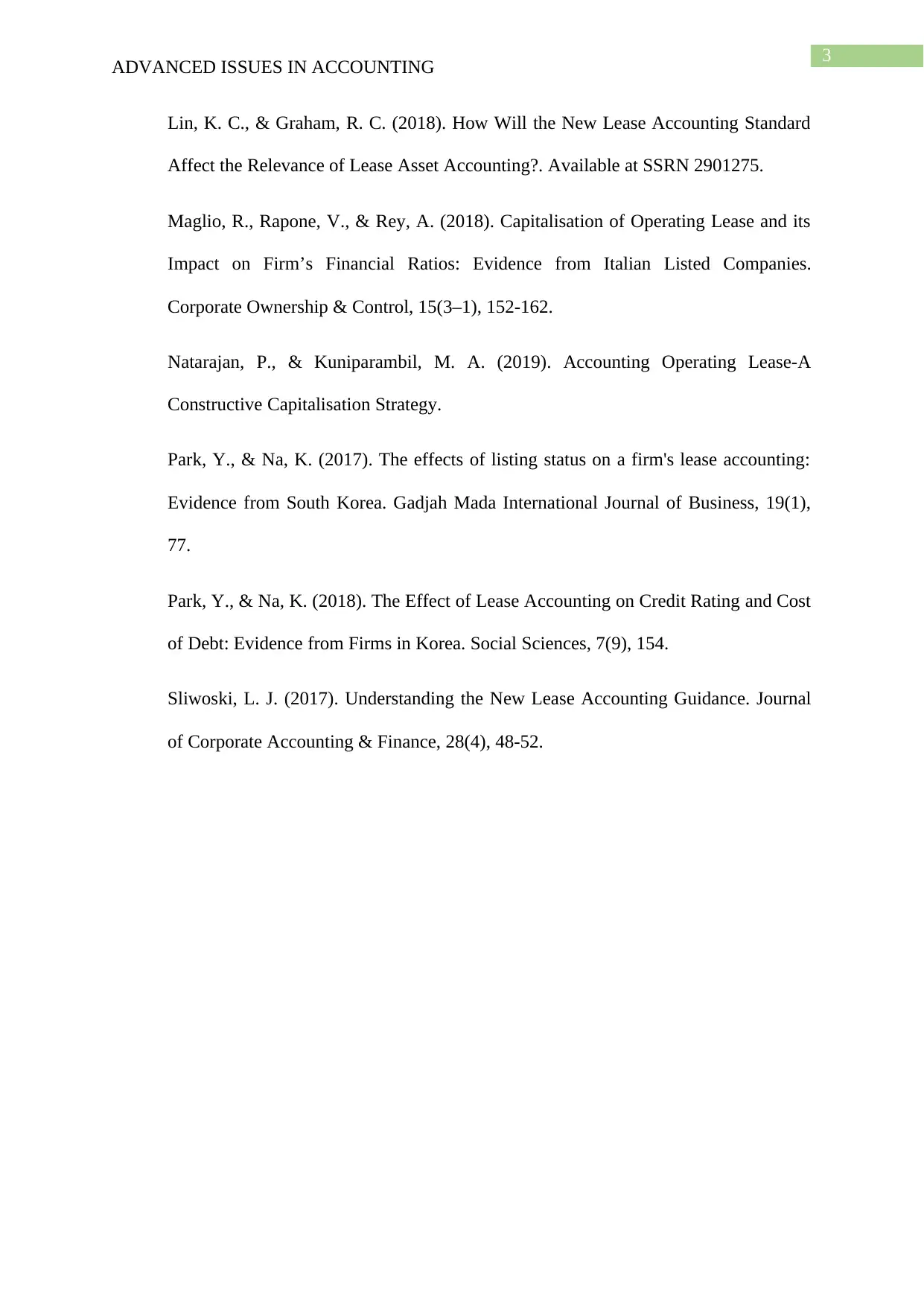
3
ADVANCED ISSUES IN ACCOUNTING
Lin, K. C., & Graham, R. C. (2018). How Will the New Lease Accounting Standard
Affect the Relevance of Lease Asset Accounting?. Available at SSRN 2901275.
Maglio, R., Rapone, V., & Rey, A. (2018). Capitalisation of Operating Lease and its
Impact on Firm’s Financial Ratios: Evidence from Italian Listed Companies.
Corporate Ownership & Control, 15(3–1), 152-162.
Natarajan, P., & Kuniparambil, M. A. (2019). Accounting Operating Lease-A
Constructive Capitalisation Strategy.
Park, Y., & Na, K. (2017). The effects of listing status on a firm's lease accounting:
Evidence from South Korea. Gadjah Mada International Journal of Business, 19(1),
77.
Park, Y., & Na, K. (2018). The Effect of Lease Accounting on Credit Rating and Cost
of Debt: Evidence from Firms in Korea. Social Sciences, 7(9), 154.
Sliwoski, L. J. (2017). Understanding the New Lease Accounting Guidance. Journal
of Corporate Accounting & Finance, 28(4), 48-52.
ADVANCED ISSUES IN ACCOUNTING
Lin, K. C., & Graham, R. C. (2018). How Will the New Lease Accounting Standard
Affect the Relevance of Lease Asset Accounting?. Available at SSRN 2901275.
Maglio, R., Rapone, V., & Rey, A. (2018). Capitalisation of Operating Lease and its
Impact on Firm’s Financial Ratios: Evidence from Italian Listed Companies.
Corporate Ownership & Control, 15(3–1), 152-162.
Natarajan, P., & Kuniparambil, M. A. (2019). Accounting Operating Lease-A
Constructive Capitalisation Strategy.
Park, Y., & Na, K. (2017). The effects of listing status on a firm's lease accounting:
Evidence from South Korea. Gadjah Mada International Journal of Business, 19(1),
77.
Park, Y., & Na, K. (2018). The Effect of Lease Accounting on Credit Rating and Cost
of Debt: Evidence from Firms in Korea. Social Sciences, 7(9), 154.
Sliwoski, L. J. (2017). Understanding the New Lease Accounting Guidance. Journal
of Corporate Accounting & Finance, 28(4), 48-52.
1 out of 10
Related Documents
Your All-in-One AI-Powered Toolkit for Academic Success.
+13062052269
info@desklib.com
Available 24*7 on WhatsApp / Email
![[object Object]](/_next/static/media/star-bottom.7253800d.svg)
Unlock your academic potential
© 2024 | Zucol Services PVT LTD | All rights reserved.





